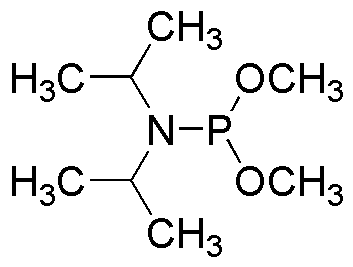Dimethyl-N,N-diisopropylphosphoramidite is widely utilized in research focused on:
- Nucleic Acid Synthesis: This compound is a key reagent in the synthesis of oligonucleotides, which are essential for genetic research, diagnostics, and therapeutic applications.
- Phosphoramidite Chemistry: It serves as a versatile building block in the development of phosphoramidite derivatives, enhancing the efficiency of chemical reactions in organic synthesis.
- Drug Development: Its unique properties allow for the modification of pharmaceutical compounds, aiding in the design of more effective drugs with improved bioavailability.
- Bioconjugation: The compound is used in creating bioconjugates, which are important for targeted drug delivery systems and in the development of diagnostic tools.
- Research in Material Science: It plays a role in the synthesis of new materials, including polymers and nanomaterials, contributing to advancements in various industrial applications.
General Information
Properties
Safety and Regulations
Applications
Dimethyl-N,N-diisopropylphosphoramidite is widely utilized in research focused on:
- Nucleic Acid Synthesis: This compound is a key reagent in the synthesis of oligonucleotides, which are essential for genetic research, diagnostics, and therapeutic applications.
- Phosphoramidite Chemistry: It serves as a versatile building block in the development of phosphoramidite derivatives, enhancing the efficiency of chemical reactions in organic synthesis.
- Drug Development: Its unique properties allow for the modification of pharmaceutical compounds, aiding in the design of more effective drugs with improved bioavailability.
- Bioconjugation: The compound is used in creating bioconjugates, which are important for targeted drug delivery systems and in the development of diagnostic tools.
- Research in Material Science: It plays a role in the synthesis of new materials, including polymers and nanomaterials, contributing to advancements in various industrial applications.
Documents
Safety Data Sheets (SDS)
The SDS provides comprehensive safety information on handling, storage, and disposal of the product.
Product Specification (PS)
The PS provides a comprehensive breakdown of the product’s properties, including chemical composition, physical state, purity, and storage requirements. It also details acceptable quality ranges and the product's intended applications.
Certificates of Analysis (COA)
Search for Certificates of Analysis (COA) by entering the products Lot Number. Lot and Batch Numbers can be found on a product’s label following the words ‘Lot’ or ‘Batch’.
*Catalog Number
*Lot Number
Certificates Of Origin (COO)
This COO confirms the country where the product was manufactured, and also details the materials and components used in it and whether it is derived from natural, synthetic, or other specific sources. This certificate may be required for customs, trade, and regulatory compliance.
*Catalog Number
*Lot Number
Safety Data Sheets (SDS)
The SDS provides comprehensive safety information on handling, storage, and disposal of the product.
DownloadProduct Specification (PS)
The PS provides a comprehensive breakdown of the product’s properties, including chemical composition, physical state, purity, and storage requirements. It also details acceptable quality ranges and the product's intended applications.
DownloadCertificates of Analysis (COA)
Search for Certificates of Analysis (COA) by entering the products Lot Number. Lot and Batch Numbers can be found on a product’s label following the words ‘Lot’ or ‘Batch’.
*Catalog Number
*Lot Number
Certificates Of Origin (COO)
This COO confirms the country where the product was manufactured, and also details the materials and components used in it and whether it is derived from natural, synthetic, or other specific sources. This certificate may be required for customs, trade, and regulatory compliance.


